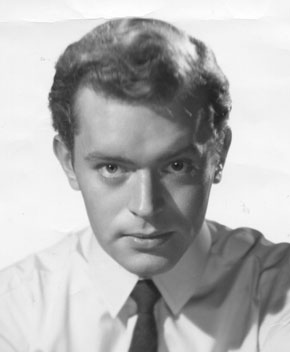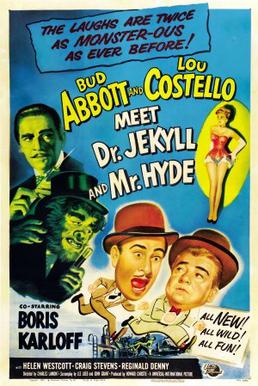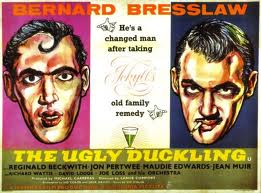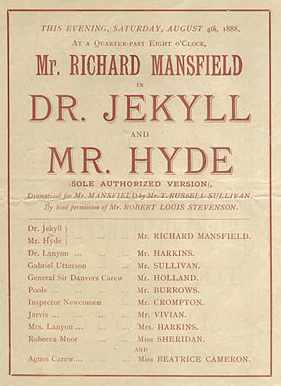
Desmond Wilkinson Llewelyn was a Welsh actor. He was best known for his role as Q in 17 of the James Bond films between 1963 and 1999.

Dr. Jekyll and Mr. Hyde is a 1931 American pre-Code horror film, directed by Rouben Mamoulian and starring Fredric March, who plays a possessed doctor who tests his new formula that can unleash people's inner demons. The film is an adaptation of The Strange Case of Dr. Jekyll and Mr. Hyde, the 1886 Robert Louis Stevenson tale of a man who takes a potion which turns him from a mild-mannered man of science into a homicidal maniac.
Hammer Film Productions Ltd. is a British film production company based in London. Founded in 1934, the company is best known for a series of Gothic horror and fantasy films made from the mid-1950s until the 1970s. Many of these involve classic horror characters such as Baron Victor Frankenstein, Count Dracula, and the Mummy, which Hammer reintroduced to audiences by filming them in vivid colour for the first time. Hammer also produced science fiction, thrillers, film noir and comedies, as well as, in later years, television series.

Dr. Henry Jekyll, nicknamed in some copies of the story as Harry Jekyll, and his alter ego, Mr. Edward Hyde, is the central character of Robert Louis Stevenson's 1886 novella Strange Case of Dr Jekyll and Mr Hyde. In the story, he is a good friend of main protagonist Gabriel John Utterson.

Terence Fisher was a British film director best known for his work for Hammer Films.

David Kossoff was a British actor. In 1954 he won the BAFTA Award for Most Promising Newcomer to Leading Film Roles for his appearance as Geza Szobek in The Young Lovers. He played Alf Larkin in TV sitcom The Larkins and Professor Kokintz in The Mouse that Roared (1959) and its sequel The Mouse on the Moon (1963).

The Gorgon is a 1964 British horror film directed by Terence Fisher for Hammer Films. It stars Christopher Lee, Peter Cushing, Richard Pasco and Barbara Shelley.
Jack the Ripper, a notorious serial killer who terrorized Whitechapel in 1888, has been featured in works of fiction ranging from gothic novels published at the time of the murders to modern motion pictures, televised dramas and video games.

Dr. Jekyll and Mr. Hyde is a 1941 American horror film starring Spencer Tracy, Ingrid Bergman, and Lana Turner. The production also features Donald Crisp, Ian Hunter, Barton MacLane, C. Aubrey Smith, and Sara Allgood. Its storyline is based on the 1886 Gothic novella Strange Case of Dr Jekyll and Mr Hyde written by Scottish author Robert Louis Stevenson. There have been many filmed adaptations of the novella. This movie was a remake of the Oscar-winning 1931 version starring Fredric March.

Dr. Jekyll and Sister Hyde is a 1971 British horror film directed by Roy Ward Baker based on the 1886 novella Strange Case of Dr Jekyll and Mr Hyde by Robert Louis Stevenson. The film was made by British studio Hammer Film Productions and was their third adaptation of the story after The Ugly Duckling and The Two Faces of Dr. Jekyll. The film is notable for showing Jekyll transform into a female Hyde; it also incorporates into the plot aspects of the historical Jack the Ripper and Burke and Hare cases. The title characters were played by the film's stars, Ralph Bates and Martine Beswick.

The Strange Case of Dr. Jekyll and Mr. Hyde is a 2006 adaptation of Robert Louis Stevenson's 1886 novella. It was directed by John Carl Buechler, and produced by Peter Davy, British American film producer. The film is set in modern times instead of Victorian England.

Jack Asher B.S.C. was an English cinematographer. His brother Robert Asher was a film and TV director with whom he worked on several occasions.

Dr. Jekyll and Mr. Hyde is a 1920 American silent horror film produced by Famous Players–Lasky and released through Paramount/Artcraft. The film, which stars John Barrymore, is an adaptation of the 1886 novella Strange Case of Dr Jekyll and Mr Hyde by Robert Louis Stevenson. John S. Robertson directed the production, and Clara Beranger wrote the screenplay, based on the 1887 stage play by Thomas Russell Sullivan that in turn was based on the novel.

Paul Massie was a Canadian actor and academic. He later became a theater professor at the University of South Florida in the 1970s. He remained on faculty until his retirement as professor emeritus in 1996.

Abbott and Costello Meet Dr. Jekyll and Mr. Hyde is a 1953 American horror comedy film starring the comedy team of Abbott and Costello, co-starring Boris Karloff, and directed by Charles Lamont.

Dr. Pyckle and Mr. Pryde is a 1925 American silent, black-and-white comedy film, directed by Scott Pembroke and Joe Rock.

Gerald Grant Sim was an English television and film actor who is perhaps best known for having played the rector in To the Manor Born.

Strange Case of Dr Jekyll and Mr Hyde is an 1886 novella written by the Scottish author Robert Louis Stevenson. It is about a London lawyer, Gabriel John Utterson, who investigates strange occurrences between his old friend, Dr. Henry Jekyll and the misanthropic Mr. Hyde. In a twist ending, it is revealed that Jekyll and Hyde were the same person, and that Jekyll had regularly transformed himself into Hyde by drinking a serum.

The Ugly Duckling is a 1959 British science fiction comedy film, directed by Lance Comfort and starring Bernard Bresslaw, Jon Pertwee and Reginald Beckwith. The film is a comic adaptation of Robert Louis Stevenson's 1886 Dr. Jekyll and Mr. Hyde storyline and the opening credits include "with ideas stolen from Robert Louis Stevenson". The film has no connection to the Hans Christian Andersen story. The tagline on posters was "He's a changed man after taking Jekyll's family remedy."

Dr. Jekyll and Mr. Hyde is a four-act play written by Thomas Russell Sullivan in collaboration with the actor Richard Mansfield. It is an adaptation of Strange Case of Dr Jekyll and Mr Hyde, an 1886 novella by the Scottish author Robert Louis Stevenson. The story focuses on the respected London doctor Henry Jekyll and his involvement with Edward Hyde, a loathsome criminal. After Hyde murders the father of Jekyll's fiancée, Jekyll's friends discover that he and Jekyll are the same person; Jekyll has developed a potion that allows him to transform himself into Hyde and back again. When he runs out of the potion, he is trapped as Hyde and commits suicide before he can be arrested.


















